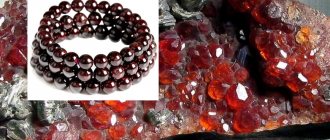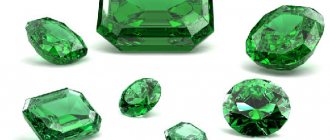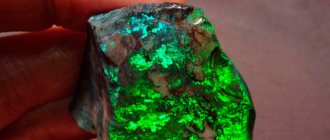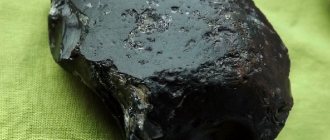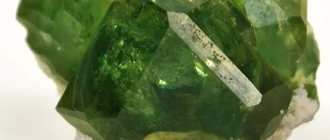Garnet stone is a versatile decoration because it has many shades and types. All of them enjoy different popularity, but recently black shades of stone are becoming more common - this is due to fashion trends. Black was once associated with mourning, but is now considered a stylish and understated option to complement an outfit. Black garnet is a group of stones with a common origin.
Melanite - black garnet
According to its content, garnet belongs to the group of silicates. The color of the stone is determined by the presence of impurities in the soil during crystal growth. And also such indicators as transparency and gloss depend on the color. Varieties of black stone include such specimens as:
- Almandine is a dark brown, almost black stone.
- Shorlomit.
- Melanitis.
The last two representatives belong to a variety of andradite stone. The black tint is given by elements such as titanium and iron in the mineral.
Physical and chemical properties
Garnet Melanite
Melanite is a titanium-calcium garnet. This is a mineral with a complex chemical composition (Ca3(Al,Fe,Ti)2[SiO4]3), in which the black color of the stone is provided by titanium. For this property, melanite is also called titanium andradite.
This variety of andradite is opaque, but some examples may show through at the edges. The hardness of the mineral is high - from 7 to 7.5 points on the Mohs scale, density - up to 3.85 g/cm³. The stone has a glassy luster and an uneven conchoidal fracture.
History and origin
Scientists found an explanation for the special relationship to the pomegranate, which illuminated the path of Noah with bright fire during the Flood, in the ancient sacred text of Ayurveda. Life arose after the Light of the Creator was reflected from the planets of the solar system and came to Earth in the form of minerals. Crystals charged with different energies appeared and dissipated like a rainbow of colors from light. Precious stones began to influence the well-being and psyche of people. Red garnet (the color of life) received and transmitted to people the energy of the Sun, which protects, eliminates diseases, and helps to survive in any situation.
Information about the mineral is contained in Egyptian papyri. Scientists of antiquity (Herodotus, Plutarch, Pliny the Elder) wrote about the properties of the stone. Pomegranate was used as a symbol of strength and victory in Arabia, Persia, China, and India. To enhance her attractiveness, the Sumerian queen Puabi (3rd century BC) surrounded her head with the rainbow glow of a natural stone, which she took with her into the afterlife. The maids of Cleopatra (prudent in choosing jewelry) massaged the body of the ruler of Egypt with the crystal, preserving the vitality and youth of the queen.
Chinese tangerines used jewelry with a gem to indicate their belonging to the second rank. Aaron knew about the magical and healing power of the gemstone. The high priest placed a deep red carbuncle (pyrope garnet) on the breastplate in the second row among 12 biblical stones.
Modern geologists have described the physical and chemical characteristics of the mineral. Using the symbols of chemical elements, scientists explained the structure of crystal compounds, color and 14 other properties. In order not to offend a gem of rare beauty and to eliminate confusion in the definition of “precious or semi-precious stone,” gemologists came up with an unconventional move. An equivalent name appeared - jewelry garnet.
Two features of the mineral:
- Less rare and durable compared to precious crystals.
- Garnet stones have unique qualities that can decorate valuable jewelry.
Origin
- Garnet is formed in the bowels of the earth in places with an abundance of kimberlite rocks with a high level of gem concentration. Not found as a single specimen. To extract one sample, the entire structure of the formation is damaged.
- The most valuable pyrope garnet for jewelers is the result of volcanic eruptions. The igneous rock combined magnesium with quartz. Bright cherry garnet is difficult to process.
Pyrope garnet (Bohemian ruby) untreated - Certain varieties of the mineral come to the surface of the earth in the form of placers. The crystal structure of garnet excludes the existence of twins.
- The mineral was found among the gold jewelry of the ancient Scythians. Historical names of garnet gemstones: anthrax in Greece (coal), carbuncle (Rome), chervonets, bechet (Russia). The Old Russian “lal” is found in fairy tales and epics. In the 13th century, the alchemist Magnus called the mineral garnet (from Latin - similar to grains).
Physicochemical characteristics
Characteristic:
- Garnet gemstones are a large group of minerals consisting of a mixture of two isomorphic series. They are found in well-defined crystals or solid granular masses. Silicon oxide contains iron, chromium, manganese and other metals. They are named after the predominant species (for example, rhodolite). The color shades of the mineral depend on the chemical properties.
- The physical properties of all types of garnets are the same. They are determined by the type of atoms (clumps of energy) and the frequency of molecular vibrations.
- Pomegranate contains concentrated individual chemical elements and a set from the periodic table.
- Visually, the stone looks like a small pomegranate nest. There are specimens the size of a pigeon egg.
Peculiarities:
- Syngony (classification of crystals based on cell symmetry) - cubic
- Cleavage (the ability of crystals to split in directions) – absent
- Gloss – bright glassy, greasy, opaque
- Hardness: 6.5 - 7 on the Mohs scale (assessment of the hardness of materials by scratching)
- Fracture - uneven
- Density (in g/cm3) depends on the type of mineral
- Has pyroelectric properties (after rubbing, it attracts straws, fluff, etc.)
- Features: high ability to diffuse light, wear resistance, resistance to aggressive environments, fading, mechanical, chemical, thermal strength
- Shades of color (green, yellow) are associated with different contents of iron, aluminum, calcium and manganese
Mining locations
- The geography of the world's garnet deposits covers all continents. Development is carried out in: Brazil, South Africa, Norway, USA, Russia, Czech Republic, Ukraine, India, Sri Lanka, Canada and other countries.
- Large deposits are located in the southern part of the USA.
- Rare specimens (cat's eye) are found in Sri Lanka.
- Blue garnet (rhodolite) is mined in Tanzania and Kenya.
- The purest examples of green garnet were born in Russia (Ural deposits).
- Rich deposits are concentrated in the Czech Republic, where beautiful and high-quality garnets are mined. Czech (Bohemian) minerals are the most expensive in the world.
Magic Garnet - Czech garnet museum in Prague
Varieties and colors
Based on their isomorphic nature (the ability of atoms or molecules to replace each other in crystals), two series of garnets are distinguished:
- Pyralspites (contain magnesium, iron, manganese: pyrope, spessartine, almandine).
- Ugrandites or calcium garnets: demantoid, uvarovite, grossular (“gooseberry”), topazolite, etc.
Scientists have created artificial garnets (synthetic). This rare type of stone is comparable in quality to diamond and alexandrite.
The category of semi-precious stones includes:
- Pyrope - red, orange, purple
- Spessartine - orange with a hint of brown
- Almandine - purple, red, black, crimson
- Uvarovite – emerald green
- Grossular - yellow, green
- Topazolite - yellow honey color
- Demantoid - green
- Melanite, shoplomite, andradite - black garnet
- Minerals of all colors are mined.
Natural garnets (classic) contain shades of red.
Application area
The mineral is used:
- in the space, rocket, construction, abrasive industries;
- in quantum and microelectronics, computer technology;
- manufacturing of high-tech equipment;
- in jewelry;
- in subjects of religion and worship.
- Participate in the formation of mineral deposits.
- Of the 14 types of garnet stones, several varieties are used for inlay.
- Rare specimens form the basis of collection material in scientific laboratories and museums.
- Bright cherry stones, visually similar to rubies, are most often found in jewelry.
Varieties and colors
Black andradite is divided into varieties depending on the form of isolation:
- single crystals;
- euhedral crystals united into druses;
- dense granular accumulations;
- xenomorphic grains.
Melanite is characterized by a rich black color, which is provided by the admixture of titanium oxide in the composition. If you look deep into the stone in bright light, you can see a dark red tint.
The magical properties of melanite
Ring garnet melanite
Melanite is, first of all, a powerful amulet against any negative influence. From ancient times to this day, it has been used to protect against attacks from enemies, ill-wishers and envious people, diseases, accidents and disasters.
An amulet with a gem was worn on children to protect them from danger, damage and the “evil eye”.
It is believed that the stone bestows spiritual peace and teaches wisdom and prudence. Melanite reduces the level of conflict, helps to find the right solution to the problem, using ingenuity and ingenuity.
Melanite fights loneliness, it promotes making new acquaintances and creating love relationships.
The stone also protects against magnetic storms and absorbs negative energy accumulated by its owner.
Who is suitable according to their zodiac sign?
Stones must be selected individually, say Vedic astrologers. Each planet has its own zodiac signs. But the celestial body, which is responsible for human well-being and health, can be weakened. A precious or semi-precious stone, selected according to the natal chart, will enhance or neutralize the influence of the planet. Horoscopes present a pattern that resembles the “DNA of the soul.” The use of energetically strong garnet (a stone of Mars, Jupiter and Venus) requires caution.
The mineral of the element of Fire has a special meaning for humans and is suitable according to the horoscope for the signs presented in the table.
| Capricorns | Gain additional strength, achieve success in career and personal relationships |
| Scorpios | Pomegranate pacifies jealousy, eliminates extremes in thoughts and deeds, opens the way to mutual passion |
| Aquarius and Gemini | The stone of stability and confidence brings great achievements in business, becomes a support in personal life, helps fight inconstancy |
| Sagittarius | Increases sensuality and passion, makes you wiser, warns against troubles |
| Scales | A dark red stone for Libra is additional fire energy. Gives confidence, suggests the right decision |
| Virgo | Stones of any shade are especially suitable for indecisive and contradictory representatives of the zodiac sign. For a woman, Virgos bring special feelings, emotions, and open distant horizons. |
| Taurus | The talisman for a Taurus woman becomes a talisman of sexuality and career. Pomegranate for a male Taurus is an instrument of optimism, hard work, and pacification of temper. |
| Lions | The fiery mineral extinguishes violent emotions, removes excessive self-confidence, and brings good luck. Red and orange minerals suit successful Leos |
| Aries | Yellow garnet guarantees peace in the family |
Magicians do not advise Cancers and Pisces to wear jewelry with garnets. For the Cancer woman, the stone brings disappointment and doubt. If you are energetically incompatible, you should not even touch the stone. For Pisces, the mineral creates conflicts out of the blue and puts pressure on the subtle nature.
Medicinal properties
Melanitis
In lithotherapy, melanite is rightly called the “stone of health.” It is believed to help treat:
- respiratory tract diseases (including asthma);
- rheumatism;
- disorders of the digestive system, pancreas, spleen;
- diseases of the nervous system;
- mild mental disorders (depression, anxiety, panic attacks);
- cardiovascular diseases.
Melanite reduces toothache and promotes the regeneration of muscle tissue and bones.
Interesting to know!
In Ancient India, black andradite was used to cleanse energy flows and support the Anahata chakra. Melanite crystals were applied to the chest in the area of the heart for some time. To relieve emotional stress, it is enough to apply the mineral to the solar plexus area.
Talismans and amulets
Ring with melanite
Melanite, as a type of andradite, is a talisman of strong-willed and self-confident people. The stone will not help those who are lacking initiative, lazy and have no purpose in life. Such people, when turning to the power of the mineral, can get the opposite effect - becoming envious and unrestrained in negative emotions towards others.
The stone is necessary for those whose profession involves making quick decisions in emergency and stressful situations. These are doctors, rescuers, volunteers, and psychological aid workers. The black gem helps you focus on the problem.
Melanite is also necessary for those who want to advance their career, working in the financial and commercial fields.
The stone will help creative people find inspiration and discover their talent.
How to wear
The main requirement is for wearing the stone. It can only be used on specific days of the week - Saturday and Tuesday. Jewelry is unsuitable for everyday use, if you wear it without taking it off, an amulet that attracts good luck and gets rid of illnesses turns into a simple decoration. This is due to the fact that the powers of the natural talisman are quickly depleted and then restored during the rest period.
Esotericists claim that constant use harms not only the product, but also the person himself. If he has a weak bioenergy field, a reverse reaction is possible, so you shouldn’t risk it.
The stone functions well in tandem with other precious crystals. Its effect is enhanced by:
- blue sapphire and white pearl;
- emerald and other beryl group minerals;
- agate, topaz, pyrope.
But it is not worth combining jewelry into a single set, that is, mixing several different stones in one piece of jewelry. From the outside it looks stupid and pompous; with close contact, the stones “clog” each other’s energy.
Areas of application
Melanite looks presentable, has a high hardness coefficient and is easy to process. Thanks to these properties, it is in demand in the following areas:
- Jewelry craftsmanship - all types of jewelry are made from this gem.
- Collecting – among holders of mineralogical collections, crystals of unusual shapes and granular accumulations are of increased interest.
- Various subcultures (for example, Goths) use stone to make objects for ceremonies and rituals, and jewelry.
- Ritual paraphernalia - due to its black color, melanite is considered a mourning stone in many countries.
Melanite products
Melanite pendant
The rich black color of the stone makes it in demand among jewelers. Melanite makes beautiful inserts into men's rings, cufflinks, pendants, tie clips, bracelets, earrings, brooches and rings.
The monotony of the stone allows it to be used to make jewelry sets. Melanite is set mainly in silver, cupronickel or jewelry alloy.
Despite its presentable appearance, jewelry with black garnet is inexpensive:
- $65-70 for a melanite bracelet;
- $70-80 - for a set in silver, consisting of earrings and a ring;
- $40 – for a druse consisting of grains of black andradite, 40x60 mm in size.
Price
On Russian Internet sites you can buy jewelry and collectible material (price/RUB):
- set (earrings + ring; silver) – 5,300;
- bracelet – 5 450;
- brush units (0.7 - 3 cm) - 240 - 500;
- drusen (6x4.5x4 cm) – 2,800.
Often in product descriptions, melanite appears as a black garnet, and Kazakhstan is listed as the place of extraction of the collection material.
When setting the price, the material of the frame and the presence of other stones are important.
How to distinguish an original from a fake
Melanite has a low cost, so cheap plastic is used to imitate it. It is easy to distinguish it from a natural mineral by the following characteristics:
- real melanite, unlike plastic, shines through at the edges;
- natural stone has a high hardness index, it cannot be scratched by a sharp metal object;
- plastic is much lighter than natural mineral;
- Melanite, compared to plastic, stays cooler longer when squeezed in the palm of your hand.
When purchasing real melanite, the seller must issue a quality certificate, which contains information about the authenticity and origin of the stone.
Compatibility with other stones
A large group of minerals is collected under the general name “garnet” (from 14 to 37 in different sources). Stones are divided according to their chemical composition, color, properties and other characteristics.
Astrologers consider the compatibility of garnet with other stones in the following areas:
- belonging to the elements (their harmony or antagonism);
- zodiac constellation;
- patron planet.
The difficulty in determining the allied stones of garnet lies in the fact that certain types of minerals correlate with different elements. For example, pyrope is a stone of Fire; uvarovite - Air. When purchasing jewelry, it is better to give preference to crystals of one element that coincide with the human element.
- Ideal combinations: emerald, sapphire, agate, hematite (bloodstone)
- Complete incompatibility: diamond, ruby, pearl, moonstone, amber
- Acceptable combination: black agate, onyx, malachite
How to care for stone
Taking care of melanitis is easy thanks to its properties. The stone is not afraid of sunlight and temperature changes. It can be stored in a common box along with the same solid natural minerals. Just don’t keep black andradite next to more fragile gems, so as not to damage them.
Melanite is easily cleaned of dirt using a damp cloth and soap solution. It is recommended to periodically clean the stone from the accumulation of negative energy. To do this, the crystal is lowered under running cold water for several minutes.
Despite its high hardness, melanite should be protected from impacts and compression.
Synthetic Garnet
Scientists have learned to grow garnets, like many other minerals, in laboratory conditions. However, this happened slowly. It all started when the American one opened a department for the study of pomegranates and their artificial cultivation in 1930. The first results were obtained in 1950-1955:
- H.-S. Yoder grew grossular, and later (together with L. Kos) he managed to obtain pyrope and almandine.
- Christophe Michel-Levy was able to synthesize spessartine and also grossular.
But their method turned out to be very expensive and unjustified (it was easier to purchase natural stones), so it did not become widespread. However, the achievements of these scientists gave impetus to further research. As a result, a solution was found through trial and error, although it was not possible to significantly reduce the cost of the process.
In the USSR, the Alexander Institute for the Synthesis of Mineral Raw Materials (VNIISIMS) distinguished itself in growing pomegranate. There they synthesized stones of all colors possible in nature - red, yellow, orange, green and impossible ones too.
It was at VNIISIMS that an incredibly beautiful dark blue garnet, which does not exist in nature, was first obtained and patented.
